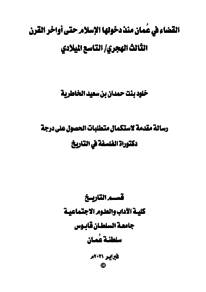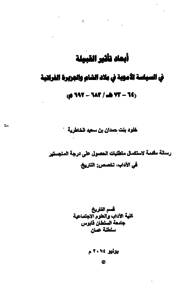Document
القضاء في عمان منذ دخولها الإسلام حتى أواخر القرن الثالث الهجري/التاسع الميلادي.
Identifier
الخاطرية, خلود بنت حمدان بن سعيد (2021). القضاء في عمان منذ دخولها الإسلام حتى أواخر القرن الثالث الهجري/التاسع الميلادي (رسالة دكتوراة، جامعة السلطان قابوس، مسقط، عمان).
Other titles
The Judiciary in Oman from embracing Islam until the end of the third century AH /Ninth Century AD
Publisher
جامعة السلطان قابوس.
Gregorian
2021
Language
Arabic
Subject
English abstract
This study aims to trace the history, status, and formation of the judiciary in Oman
from the beginning of Islam until the end of the second Ibadi Imamate, as it
constituted a source of strength in the Omani history. The study also examines the
issues related to the organization of the administrative apparatus of the judiciary, its
characteristics, and its most prominent features, as well as highlighting the
contributions of judges and their role in public life. In her study, the researcher relies
on Omani jurisprudential sources, both manuscript and printed, using a descriptive
analytical method. The study is divided into four main chapters, as well as an
introduction and preface, to present the general concept of the topic understudy on
the one hand, and to understand the political situation in Oman during the period
studied on the other hand. The chapters of the study are divided as follows: Chapter I
discusses the historical development of the judiciary in Oman from the beginning of
Islam until the end of the second Ibadi Imamate. Chapter II examines the regulations
of the administrative apparatus of the judiciary, while the Chapter III highlights the
characteristics and manifestations of the judiciary. Chapter IV focuses on the
contributions of judges and their role in public life.
This study comes up with a number of conclusions, including:
- The formation of the judiciary in Oman and its organizations began small with the
rise of the First Ibadi Imamate. Despite the fact that the political organization of the
Imamate ended after two years, the practice of the judiciary was maintained by the
scholars during the transitional period between the two Imamates (132-177AH /
749-794AD). As soon as the Omanis revived their political project by declaring the
second Imamate (177 AH / 749 CE), the Imamate started to deepen its roots and
impower its various administrative institutions, including the judiciary. This resulted
in the establishment of a judicial institution that witnessed many developments and
advanced, if not integral, litigation procedures.
- The judges of Oman were the main drivers of the Imamate political system, and the
most vigilant among the People of Power and Influence, in addition to being Imams
in some cases, participating in wars, and leading military confrontations.
- The judges enriched the cultural and intellectual life with their books, which later
became the basis for encyclopedic authorship, most importantly the production of
Judge Muhammad bin Mahboub which exceeded eight books in: jurisprudence,
faith, rulings, administration, and Sharia policy.
Member of
Resource URL
Arabic abstract
هدفت الدراسة إلى تتبع تاريخ القضاء في عُمان، واقعه، وِإشكال نشأته، منذ بدء الإسلام حتى نهاية الإمامة الإباضية الثانية، إذ شكَّل القضاء -باختلاف مساراته ومعطياته- مصدر قوة في الحراك التاريخي العُماني. وبحثت الدراسة أيضًا إشكال تنظيمات الجهاز الإداري للقضاء، خصائصه، وأبرز مظاهره، ثم إسهامات القضاة ودورهم في الحياة العامة. واعتمدت الباحثة في دراستها على المصادر الفقهية العُمانية المخطوط منها والمطبوع؛ بعد معالجتها تاريخيًا بالمنهج الوصفي التحليلي. وانقسمت الدراسة إلى أربعة فصول رئيسة، وتمهيد؛ لطرح التصور العام لموضوع الدراسة من جهة، ومحاولة لفهم الأوضاع السياسية في عُمان خلال الفترة المدروسة للبحث من جهة أخرى. أمَّا فصول الدراسة فانقسمت إلى: الفصل الأول: ناقش التطور التاريخي للقضاء في عُمان منذ بدء الإسلام حتى نهاية الإمامة الإباضية الثانية، وخُصِّص الفصل الثاني لمناقشة تنظيمات الجهاز الإداري للقضاء، في حين تناول الفصل الثالث خصائص القضاء ومظاهره، وركَّز الفصل الرابع والأخير في إسهامات القضاة ودورهم في الحياة العامة.
وخلصت الدراسة إلى نتائج، أهمها:
- بدأ تشكُّل القضاء في عُمان وتنظيماته بسيطًا مع قيام الإمامة الاباضية الأولى. ورغم انتهاء تلك التجربة السياسية بعد عامين؛ إلا أن ممارسة القضاء ظلت قائمة في يد العلماء خلال الفترة الانتقالية بين الإمامتين (132- 177هـ/749-794م). وفور إحياء العُمانيين لمشروعهم السياسي بإعلان الإمامة الثانية (177هـ/749م)؛ بدأت الإمامة في تثبيت أركانها، وترسيخ مؤسساتها الإدارية المختلفة، منها القضاء؛ الذي شهد قيام مؤسسة قضائية عرفت تنظيمات وتطورات عديدة بلغت درجة متقدمة من حسن التنظيم والعمل الدقيق - وإن لم تكن مؤسسة متكاملة الأركان- في تفاصيل إجراءات التقاضي.
- مَثَّلَ تطور مصادر التشريع القضائي في عُمان، وإقبال غير المسلمين إلى القاضي العُماني، والصرامة والشدة في تطبيق الحدود والعقوبات القضائية؛ أبرز خصائص القضاء في عُمان خلال فترة الدراسة.
- كان قُضاة عُمان المُحرِّك الرئيس لأبْعاد المنظومة السياسية للإمامة ومساراتها، والأكثر تنبُّهًا مِنْ غيرهم ضمن هيئة أهل الحل والعقد، إضافةً إلى قيامهم بالإمامة، والمشاركة في إدارة الحروب، وقيادة المواجهات العسكرية.
- أَثْرى القُضاة الحياة الثقافية والفكرية بمؤلفاتهم التي أصبحت فيما بعد القاعدة الأساس للتأليف الموسوعي، وفي مُقدِّمتها مؤلفات القاضي محمد بن محبوب؛ التي تجاوزت ثمانية مؤلفات في: الفقه، العقيدة، الأحكام، الإدارة، والسياسة الشرعية
وخلصت الدراسة إلى نتائج، أهمها:
- بدأ تشكُّل القضاء في عُمان وتنظيماته بسيطًا مع قيام الإمامة الاباضية الأولى. ورغم انتهاء تلك التجربة السياسية بعد عامين؛ إلا أن ممارسة القضاء ظلت قائمة في يد العلماء خلال الفترة الانتقالية بين الإمامتين (132- 177هـ/749-794م). وفور إحياء العُمانيين لمشروعهم السياسي بإعلان الإمامة الثانية (177هـ/749م)؛ بدأت الإمامة في تثبيت أركانها، وترسيخ مؤسساتها الإدارية المختلفة، منها القضاء؛ الذي شهد قيام مؤسسة قضائية عرفت تنظيمات وتطورات عديدة بلغت درجة متقدمة من حسن التنظيم والعمل الدقيق - وإن لم تكن مؤسسة متكاملة الأركان- في تفاصيل إجراءات التقاضي.
- مَثَّلَ تطور مصادر التشريع القضائي في عُمان، وإقبال غير المسلمين إلى القاضي العُماني، والصرامة والشدة في تطبيق الحدود والعقوبات القضائية؛ أبرز خصائص القضاء في عُمان خلال فترة الدراسة.
- كان قُضاة عُمان المُحرِّك الرئيس لأبْعاد المنظومة السياسية للإمامة ومساراتها، والأكثر تنبُّهًا مِنْ غيرهم ضمن هيئة أهل الحل والعقد، إضافةً إلى قيامهم بالإمامة، والمشاركة في إدارة الحروب، وقيادة المواجهات العسكرية.
- أَثْرى القُضاة الحياة الثقافية والفكرية بمؤلفاتهم التي أصبحت فيما بعد القاعدة الأساس للتأليف الموسوعي، وفي مُقدِّمتها مؤلفات القاضي محمد بن محبوب؛ التي تجاوزت ثمانية مؤلفات في: الفقه، العقيدة، الأحكام، الإدارة، والسياسة الشرعية
Category
Theses and Dissertations



